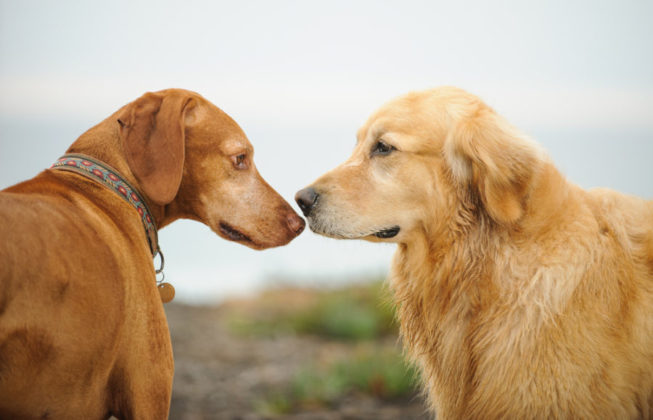Introducing a new dog into your home can sometimes be a challenge. By easing into things at a neutral location, and avoiding some common mistakes, you’ll help lay the foundation for a lifelong friendship.
My former neighbor, Tracey, has a large, lovable, laid-back yellow Labrador named Cody. Last year, she wanted to add a new dog to her family. She took Cody with her to meet the new family member – an older female Chihuahua-Jack Russell terrier mix named Maggie. Despite the vast difference in their sizes, the two dogs hit it off, and I’ve never seen or heard any discord between them.
Recently, Tracey’s son decided he wanted his own dog and brought home a Boz shepherd puppy. While Tracey and I talked outside, I watched the canine trio in amazement. All three were in close proximity – affable Cody was lying down, the puppy was relaxing at the front door, and Maggie was next to Tracey.
I asked her how she introduced these dogs to one another so easily. She said she took them to the backyard of their new house and introduced them there. Because none of the dogs had been there before, it was neutral territory. The dogs were more interested in the new space than in each other, and nobody felt threatened. The situation could have been a disaster, if not downright dangerous, had Tracey not been familiar with the art of dog introduction.
In other words, there’s a protocol to follow when it comes to introducing dogs to one another. If you want your dogs to have a strong, positive relationship throughout their lives, it’s important to build a good foundation from the start.
To learn more about the importance of correct canine introductions, and how to implement them, I spoke to Suzanne Hetts, PhD, Certifi ed Applied Animal Behaviorist and co-owner of Animal Behavior Associates, and Susan Bulanda, a Certified Animal Behavior Consultant and search-and-rescue dog trainer.
Why is it important to introduce dogs properly?
SH: “Dogs vary tremendously in terms of their socialization history and acceptance of unfamiliar animals in their home/territory. You want the relationship to be friendly and pleasant from the getgo. You don’t want the dogs to have an unpleasant encounter, skirmish or conflict, and then have to overcome that problem. Having friendly interactions and preventing unpleasant feelings from the start builds the foundation for a good relationship.”
SB: “Dogs are similar to people in many ways. They have likes and dislikes just as we do. Some have had bad experiences with certain types of dog and will never trust those types again. Conversely, some dogs have preferences for certain types of dog. The only way you can find out for sure if your dog will like the new dog, or vice versa, is to bring them together a few times, though not by simply bringing the new dog into your home without proper introductions.”
Do you agree with introducing dogs in a neutral, open area before bringing the new one home?
SH: “Using a neutral location is a good idea because it prevents problems; you don’t trigger any territorial or possessive behaviors around the property and/or the resident dog’s favorite spaces. The new dog hasn’t really established any place of his own yet.”
SB: “Yes, it is important to introduce dogs in a neutral area – and wait until they are friends before bringing them home. This may take a few introductions. You will know they are friends when they pull together or show other signs of friendly recognition.”
Do you recommend scent introduction at home before face-to-face introduction?
SH: “In my experience, the scent introduction is more important for cats than dogs. If you are in the position to do a scent introduction and keep the dogs separated at first, it’s an okay approach, but the neutral territory introduction is the standard. If you’re talking about two adult dogs, keep them on a leash when you first bring them into the house together; let them drag the leashes, or put one dog behind a baby gate in another room, but always supervise them. Safety is always an issue, especially with a puppy introduction or a when there’s a size discrepancy between the dogs.”
SB: “If you have already followed the neutral ground introduction, there is no need for scent introduction at home. And if you separate the dogs in your home, you are setting things up for them to claim areas for themselves. Nevertheless, you should keep a close eye on them for the first few days. Keep in mind that if you are adopting an older dog, it takes about six to eight weeks for him adjust to his new home. During that time, the relationship between the dogs could change, along with the dog’s relationship to the new person/home environment. People tend to forget that the new dog has no clue why has been re-homed, and by the same token, no clue that his new family wants and loves him. He needs time to bond with everyone, including your resident dog.”
What mistakes do people often make when introducing dogs to one another?
SH: “There are several potential mistakes:
- It starts with selecting a new dog. People choose a second or third dog based on their own desires, without considering what types of dog might do well with the one(s) they already have.
- There’s still too much of the old-school mentality that says “just let them work it out”. Because of the variables in each dog’s social skills, and willingness to be social, that’s a very risky way to start a relationship you want to last 15 years or more.
- Many people expect too much too soon from the dogs, and micromanage their interactions.
- People also don’t consider the safety issue enough. We’ve seen too many cases in which dogs have been physically injured, or suffered behavioral harm.
- Finally, many people don’t recognize when one animal is being intimidated by another, to the extent that it’s affecting the dog’s quality of life. The intimidated dog is always trying to avoid or fly under the radar of the other dog, and may be afraid to do certain things. People think that’s a normal relationship and it really isn’t. They don’t recognize how intimidation and harassment can affect the victimized dog.”
SB: “The biggest mistake people make is not being able to read the dog’s body language, or know what a proper canine greeting is. People tend to hold dogs on a tight leash, which can cause them to react to each other in a negative way. People also misread their dogs, mistaking aggression for play when the two dogs don’t favor each other.”
If someone is short on time, is there a “speed-dating” version of dog introduction?
SH: “No. Theoretically, maybe, but if you don’t have the time to spend nurturing a new relationship between two dogs, then don’t get another dog. Plan things so you have a week or two to really focus on starting their relationship properly, so they can live peaceably in your family for the rest of their lives. If you can’t do that, it may not be the right time to add another dog to your family. Delay the acquisition until you have the time to devote to introducing them properly.”
SB: “In some cases, you may have two dogs who are ‘social butterflies’, and you already know they get along well with other dogs in general. One long introductory meeting may work, but you’d have to understand both dogs’ personalities well enough to try this. I teach my students that nothing works all of the time and everything works some of the time.”
If you’re planning to add another canine companion to your household, be sure to do it properly. Throwing them in together with no warning or preparation could result in a fearful and/or aggressive reaction from one or both dogs, and a damaged relationship from day one. By taking the time to ease into the introductions at a neutral location, and avoiding the common mistakes outlined above, you’ll help ensure your dogs make lifelong friends.
For more information on healthy animal interactions, view this webinar at petprowebinars.com/courses-by-instructor/creating-and-maintaining-healthy-relationships-among-family-dogs/


